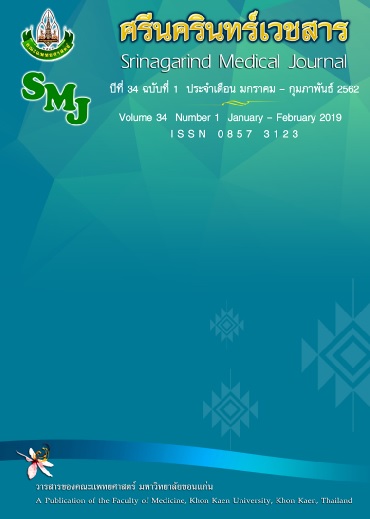ผลของภาระงานคอมพิวเตอร์ต่ออาการผิดปกติของรยางค์ส่วนบน คอ และหลังจากการทำงานในกลุ่มพนักงานสำนักงาน
คำสำคัญ:
อาการผิดปกติทางระบบกล้ามเนื้อและกระดูกโครงร่าง; พนักงานสำนักงาน; ภาระงานคอมพิวเตอร์บทคัดย่อ
หลักการและวัตถุประสงค์: อาการผิดปกติทางระบบกล้ามเนื้อและกระดูกโครงร่างเป็นปัญหาจากการทำงานที่สำคัญในกลุ่มพนักงานที่ใช้คอมพิวเตอร์ การศึกษานี้มีวัตถุประสงค์เพื่อศึกษาความชุกและผลของภาระงานคอมพิวเตอร์ต่ออาการผิดปกติทางระบบกล้ามเนื้อและกระดูกโครงร่างในกลุ่มพนักงานสำนักงาน
วิธีการศึกษา: เก็บรวบรวมข้อมูลจากพนักงานสำนักงานที่ใช้คอมพิวเตอร์ของมหาวิทยาลัยแห่งหนึ่ง จำนวน 260 คน โดยใช้แบบสอบถามเกี่ยวกับข้อมูลทั่วไปและข้อมูลอาการผิดปกติทางระบบกล้ามเนื้อและกระดูกโครงร่าง วิเคราะห์ผลของภาระงานคอมพิวเตอร์ต่ออาการผิดปกติทางระบบกล้ามเนื้อและกระดูกโครงร่างโดยใช้สถิติ Multiple logistic regression พร้อมทั้งนำเสนอค่า Adjusted Odds Ratio (OR) และ 95% CI
ผลการศึกษา: คะแนนถ่วงน้ำหนักเฉลี่ยของอาการผิดปกติทางระบบกล้ามเนื้อและกระดูกโครงร่างของพนักงานสำนักงานสูงสุด 3 ลำดับแรก ได้แก่ หลังส่วนล่าง (15.22 ± 20.39) คอ (14.87 ± 21.91) และไหล่ด้านขวา (12.01 ± 22.28) ตามลำดับ ขณะที่ความชุกของอาการพบสูงสุดในบริเวณคอ (ร้อยละ 82.70) หลังส่วนล่าง (ร้อยละ 74.60) และไหล่ข้างขวา (ร้อยละ 61.90) ตามลำดับ กลุ่มตัวอย่างส่วนใหญ่มีภาระงานคอมพิวเตอร์สูง (ระยะเวลาใช้คอมพิวเตอร์มากกว่าหรือเท่ากับ 7 ชั่วโมงต่อวัน) ร้อยละ 52.3 ผลการวิเคราะห์แบบพหุโลจิสติกส์ พบว่า กลุ่มที่มีภาระงานคอมพิวเตอร์สูงมีโอกาสเสี่ยงต่อการเกิดอาการปวดบริเวณไหล่ข้างซ้าย (Adjusted OR = 2.11, 95%CI = 1.22 - 3.64) ไหล่ข้างขวา (Adjusted OR = 1.81, 95%CI = 1.04 - 3.16) แขนส่วนล่างซ้าย (Adjusted OR = 2.15, 95%CI = 1.13 - 4.08) แขนส่วนล่างขวา (Adjusted OR = 2.02, 95%CI = 1.10 - 3.70) ข้อมือซ้าย (Adjusted OR = 2.25, 95%CI = 1.23 - 4.14) และข้อมือขวา (Adjusted OR = 1.78, 95%CI = 1.00 - 2.95) สูงกว่ากลุ่มภาระงานคอมพิวเตอร์ต่ำอย่างมีนัยสำคัญทางสถิติ
สรุป: ผลการศึกษาชี้ให้เห็นว่าภาระงานคอมพิวเตอร์สูงมีโอกาสเสี่ยงต่อการเกิดอาการผิดปกติทางระบบกล้ามเนื้อและกระดูกโครงร่าง จึงควรบริหารจัดการภาระงานการใช้คอมพิวเตอร์อย่างเหมาะสม
เอกสารอ้างอิง
2. จามรี สอนบุตร, พิชญา พรรคทองสุข, สุภาภรณ์ เต็งไตรสรณ์. ความชุกและปัจจัยที่มีผลต่อความล้าของตาในผู้ปฏิบัติงานกับเครื่องคอมพิวเตอร์ของคณะแพทยศาสตร์ มหาวิทยาลัยสงขลานครินทร์. สงขลานครินทร์เวชสาร 2552; 27: 91-104.
3. Bernard BP. Musculoskeletal disorders and workplace factors: Critical review of epidemiology evidence for work-related musculoskeletal disorders of the neck, upper extremity and low back factors. 1997 [Cited May 9, 2017]. Available form: https://www.cdc.gov/niosh/docs/97-141/pdfs/97-141.pdf
4. Simoneau S, ST-Vincent M, Chioine D. Work-Related Musculoskeletal Disorders (WMSDs), 1996 [Cited 2017 May 9]. Available form: http://www.irsst.qc.ca/media/documents/PubIRSST/RG-126-ang.pdf
5. Infrastructure Health & Safety Association. Musculoskeletal disorders (MSDs) Risk factors, [Cited 2017 May 9]. Available form: https://www.ihsa.ca/pdfs/safety_talks/msd_risk_factors.pdf
6. Janwantanakul P, Pensri P, Jiamjarasrangsi W, Sinsongsook T. The relationship between upper extremity musculoskeletal symptoms attributed to work and risk factors in office workers. Int Arch Occup Environ Health 2010; 83: 273–81.
7. Cho CY, Hwang YS, Cherng RJ. Musculoskeletal symptoms and associated risk factors among office workers with high workload computer use. J Manipulative Physiol Ther 2012; 35: 534-40.
8. Ayanniyi O, Ukpai BOO, and Adeniyi AF. Differences in prevalence of self-reported musculoskeletal symptoms among computer and non-computer users in a Nigerian population: a cross-sectional study. BMC Musculoskeletal Disorders 2010; 11: 177.
9. Janwantanakul P, Pensri P, Jiamjarasrangsri V, Sinsongsook T. Prevalence of self-reported musculoskeletal symptoms among office workers. Occup Med (Lond) 2008; 58: 436-8.
10. Mainenti MR, Felicio LR, Rodrigues Ede C, Ribeiro da Silva DT, Vigário Dos Santos P. Pain, Work-related Characteristics, and Psychosocial Factors among Computer Workers at a University Center. J Phys Ther Sci 2014; 26: 567-73.
11. Eltayeb S, Staal JB, Hassan A, de Bie RA. Work related risk factors for neck, shoulder and arms complaints: a cohort study among Dutch computer office workers. J Occup Rehabil 2009; 19: 315-22.
12. Saleem M, Priya S, Govindarajan R, Balaji E, Diwahar Anguraj J, ShylendraBabu PG, et al. A cross sectional study on work related musculoskeletal disorders among software professionals. Int J Community Med Public Health 2015; 2: 367-72.
13. เมธินี ครุสันธิ์ และสุนิสา ชายเกลี้ยง. การประเมินความเสี่ยงทางการยศาสตร์ในพนักงานสำนักงานมหาวิทยาลัย. วารสารวิจัย มข. 2557; 19: 696-707.
14. พาวิณี ใจบาน, วีระพร ศุทธากรณ์ และธานี แก้วธรรมานุกูล. ปัจจัยด้านการยศาสตร์และอาการผิดปกติโครงร่างกล้ามเนื้อ ของบุคลากรสายสนับสนุนในโรงพยาบาลที่ทำงานกับคอมพิวเตอร์. พยาบาลสาร 2556; 40: 1-11.
15. Melek Ardahan and Hatice Simsek. Analyzing musculoskeletal system discomforts and risk factors in computer-using office workers. Pak J Med Sci 2016; 32: 1425-29.
16. Moom RK, Sing LP, Moom N. Prevalence of Musculoskeletal Disorder among Computer Bank Office Employees in Punjab (India): A Case Study. Procedia Manufacturing 2015; 3: 6624-31.
17. Chaikaen W, Chanprasit C, Kaewthummanukul T. Ergonomic Factors and Prevalence Rate of Musculoskeletal Pain among Workers in SemiconductorIndustries in the NorthernRegion Industrial. JHealthScience 2007; 16: 226-33.
18. Hedge A. Ergonomics with flair. Popular Mech 2003; 108: 28-9.
19. Andersen JH, Harhoff M, Grimstrup S, Vilstrup I, Lassen CF, Brandt LP, et al. Computer mouse use predicts acute pain but not prolonged or chronic pain in the neck and shoulder. Occup Environ Med 2008; 65: 126-31.
20. Chang CH, Amick BC, Menendez CC, Katz JN, Johnson PW, Robertson M, et al. Daily computer usage correlated with undergraduate students' musculoskeletal symptoms. Am J Ind Med 2007; 50: 481–8.
21. Ortiz-Hernández L, Tamez-González S, Martínez-Alcántara S, Mé;ndez-Ramírez I. Computer use increases the risk of musculoskeletal disorders among newspaper office workers. Arch Med Res 2003; 34: 331-42.
22. Ijmker S, Huysmans MA, van der Beek AJ, Knol DL, van Mechelen W, Bongers PM, et al. Software-recorded and self-reported duration of computer use in relation to the onset of severe arm-wrist-hand pain and neck-shoulder pain. Occup Environ Med 2011; 68: 502-9.
23. Cochran WG. (1953). Sampling Techiques. New York: John Wiley & Sons. Inc.
24. ภัทรศยาภรณ์ บุญตาแสง. ความชุกของอาการความผิดปกติของระบบโรงร่างกระดูกและกล้ามเนื้อและการประเมินความเสี่ยงด้วยเทคนิค ROSA ในพนักงานสายสนับสนุนในมหาวิทยาลัยแห่งหนึ่ง[วิทยานิพนธ์วิทยาศาสตรบัณฑิต]. พิษณุโลก: มหาวิทยาลัยนเรศวร; 2559.
25. Hedge A, Morimoto S, McCrobie D. Effects of keyboard tray geometry on upper body posture and comfort. Ergonomics 1999; 42: 1333-49.
26. Collins JD, O'Sullivan LW. Musculoskeletal disorder prevalence and psychosocial risk exposures by age and gender in a cohort of office based employees in two academic institutions. International Journal of Industrial Ergonomics 2015; 46: 85-97.
27. พรทิพย์ จงใจ. ปัจจัยเสี่ยงของกลุ่มอาการผิดปกติทางระบบโครงร่างและกล้ามเนื้อของรยางค์ส่วนบนในผู้ประกอบอาชีพกรีดยางพารา[วิทยานิพนธ์พยาบาลศาสตรมหาบัณฑิต]. ชลบุรี: มหาวิทยาลัยบูรพา; 2557.




